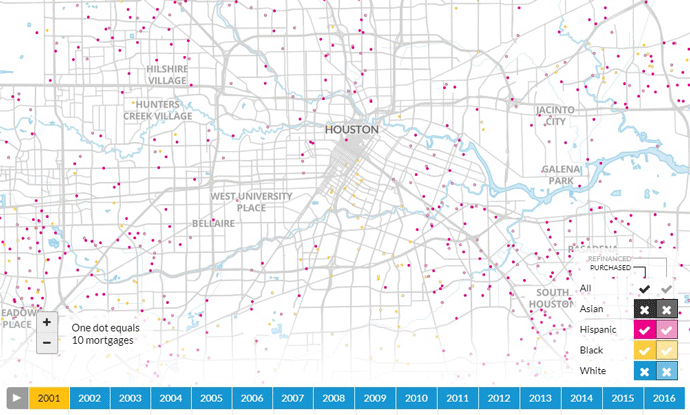
<p>A man and woman are is shown in front of the skyline from Bernal Heights Hill in San Francisco, Wednesday, March 2, 2016. Photo by Jeff Chiu/AP.</p>
Recently released mortgage data from 2016 reveal where America stands 10 years after the peak of the housing bubble. Our newly expanded interactive map uses these data to illuminate how the recovery has left minority homebuyers behind in some places, and where serious work remains to achieve an inclusive housing recovery.
At the peak of the boom, minority borrowers made up a large share of mortgage originations nationwide. Twenty-five percent of the 12.2 million mortgages originated in 2006 went to black or Hispanic borrowers when these two groups represented 28 percent of the population.
This marked a significant increase from 2001, when these groups accounted for just 14 percent of the 12.6 million new mortgages. In 2016, despite representing 31.1 percent of the population, black and Hispanic borrowers represented just under 17 percent of the 7.5 million newly originated mortgages. Not only is the share smaller than it was 10 years ago, the number of loans originated is almost half of what it was in the earlier period.
As we’ve noted in previous work, this trend is troubling because minority borrowers were hit especially hard during the housing crisis, and they continue to face barriers to accessing credit, as lending standards have significantly tightened. Many potential homeowners have missed out on the chance to obtain a low interest rate and will continue to face headwinds now that interest rates and home prices are rising.
National numbers only give us part of the story. A closer look at three cities, using our newly expanded Home Mortgage Disclosure Act (HMDA) mapping tool, demonstrates how uneven the recovery has been.
Detroit’s recovery has been far from inclusive for black borrowers

Black borrowers experienced large gains in Detroit in 2006, when the housing bubble was at its peak. The black share of purchase mortgage originations was 21 percent, and the share of refinanced mortgages was 15 percent. In 2001, these shares stood at 10 and 11 percent, respectively.
Since the crisis, Detroit has grappled with supply and demand issues because of persistent blight and uneven economic growth that has been concentrated in select downtown areas. In 2016, mortgages made to black borrowers made up just 8 percent of purchases and 5 percent of refinances. Meanwhile, in a city that is 84 percent black, Hispanic purchase and refinance rates are above 2001 levels, and white rates are above 2006 levels.
San Francisco’s rapid growth has left Hispanic borrowers behind

In 2001, mortgages made to Hispanic borrowers made up 15 percent of purchase originations in San Francisco. The boom years saw a massive increase in these mortgages. In 2006, over 25 percent of purchase mortgages and 21 percent of refinance mortgages were made to Hispanic borrowers.
Immediately after the crisis, the Hispanic share of purchase mortgages dropped to 10 percent. The share of refinance mortgages also plunged, dipping to 5 percent in 2010.
Since then, the Bay Area has experienced rapid economic growth, coupled with limited new home construction, pricing out minority residents. The Hispanic share of originations stood at 11 percent for purchase mortgages and less than 10 percent for refinance mortgages in 2016. Meanwhile, white shares are above their 2006 levels.
Houston’s recovery has been relatively uniform across racial and ethnic groups

The housing boom in Houston saw a dramatic increase in both black and Hispanic mortgage originations. From 2001 to 2006, the black share of purchase originations rose from 9 to 15 percent, while the refinance share rose from 9 to 17 percent. In the same period, the Hispanic share of purchase originations rose from 19 to 26 percent, and the refinance share rose from 17 to 26 percent.
Although minorities in Houston experienced losses after the crisis, they have rebounded.
Houston has developed new homes rapidly, keeping pace with the burgeoning economy. In 2016, the share of purchase mortgages made to black borrowers was 11 percent, and the share of refinance mortgages was 12 percent. For Hispanic borrowers, the share was 23 percent for purchase originations and 19 percent for refinance mortgages.
Our newly expanded interactive HMDA map allows users to scan through 16 years of data for 130 million mortgages for any US region and see how different racial and ethnic groups have fared. Users can zoom into different areas and see the number of mortgages made to racial and ethnic groups for every year since 2001.
We’ve also included the ability to see refinance and purchase loans separately. Other analyses we’ve completed using HMDA data illuminate additional facets of today’s housing market, such as the number of loans that have been suppressed because of overly tight credit standards and the denial rates for today’s mortgage applicants.
Ten years after the housing boom, the recovery continues to differ not only across America’s racial and ethnic groups but across its cities. Detroit, San Francisco, and Houston show that economic growth alone is not enough to ensure economic success for all city residents. As long as supply constraints and tight mortgage lending are the norm, significant barriers will remain for minorities seeking to access the wealth-building potential of homeownership.
Let’s build a future where everyone, everywhere has the opportunity and power to thrive
Urban is more determined than ever to partner with changemakers to unlock opportunities that give people across the country a fair shot at reaching their fullest potential. Invest in Urban to power this type of work.